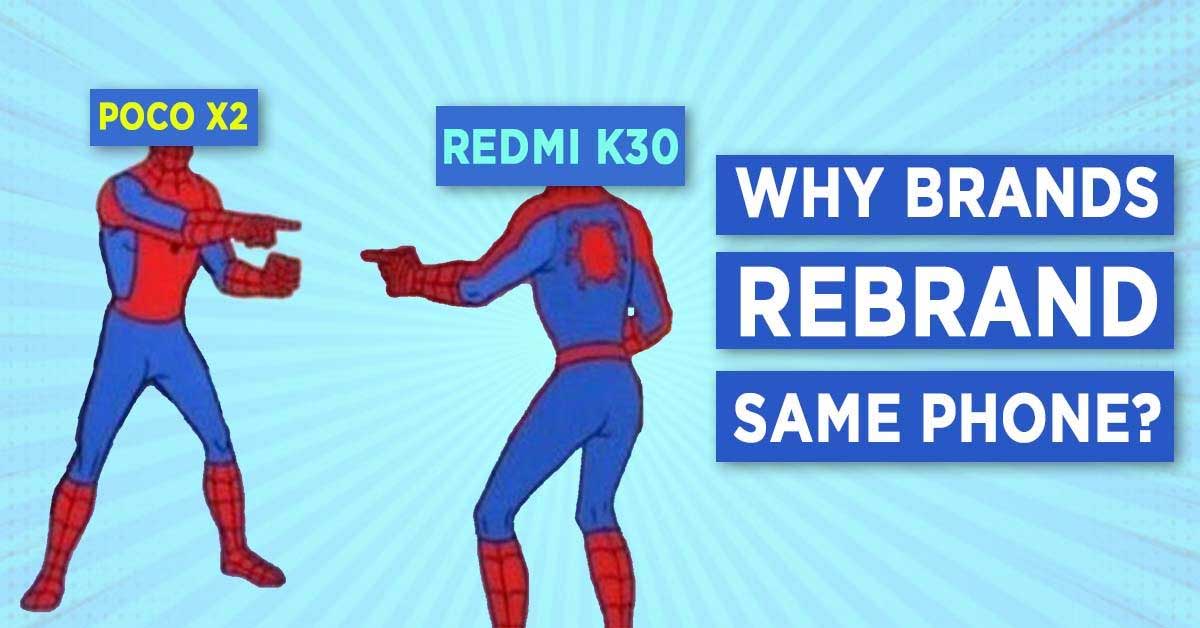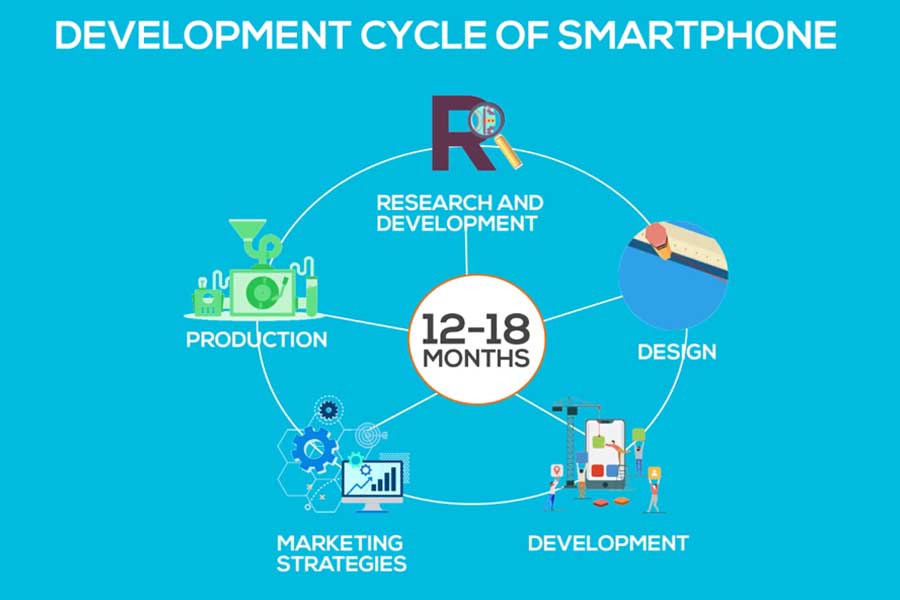
The new POCO F2 Pro just launched a couple of weeks ago. But wait, it is identical to the Redmi K30 Pro that launched like 2 months ago. Similarly, the Narzo 10 is a rebranded Realme 6i. Confusing and weird right? Why do smartphone companies launch (rebrand) the same phone with different names? Basically, there are 2 reasons for it.
Why companies rebrand the same phone?
Reason #1: To Expand Brand’s Reach in all Direction
Let me explain this by giving an example of Xiaomi India. When Xiaomi first arrived in the country, it was an online-exclusive brand. But brick & mortar stores were and is still a big part of consumer daily life and more than 50% of users buy phones offline. Hence, Xiaomi significantly expanded its offline retail footprint in 2019 to expand sales.
As of now, Xiaomi has over 100 Mi Home stores and around 2500 smaller sized Mi Stores across 600 cities and towns of India. Because of this, Xiaomi’s offline sales have grown by around 40 times in the last couple of years. And as of now, the company’s online vs offline sales occupy a 50-50 market share.

However, this has created a big issue between offline and online sellers – price difference. The phones sold online are often cheaper than when sold in offline stores. The price difference is even more prominent during festivals, sales carnivals, and such when e-commerce platforms introduce big discounts & offers.
Similarly, another concern for the retail shops is that customers use their shops to check for the products, but because of huge discounts online, they will instead buy it there.
According to one owner of a mobile shop, the higher price of phones in offline shops is not because of the rent for the physical space or the distribution of profit margin throughout the supply chain. But it is indeed because of the heavy discounts given by the e-commerce platform.
Cash burn & other techniques
Ecommerce has the ability to sell phones at a nominal margin and even at loss sometimes, often termed as “cash burn”. It is a strategy by which an e-commerce platform intentionally loses money just to be able to compete in the market, in order to build a good rapport with its customers in the long run.
Arvinda Khurana, the national president of Mobile Retailers Association of India, said:
“Online platforms sold smartphones at prices much lower than even the buying price for retailers. And this has hurt the offline industry badly.”
Hence, there has always been a dispute between offline channels and online channels. So, the mobile brand had to figure out a way to keep both these practices healthy. To tackle this issue, Xiaomi now has multiple sub-brands under its name. Here, the parent brand Mi and Redmi focus on offline stores while the new sub-brand POCO is an online-exclusive entity.

POCO being an online-exclusive brand will compete against other online products with its aggressive pricing and cash burn. On the other side, the parent brands, Redmi & Mi, would keep fighting offline. Hence, we could see POCO launching the POCO F2 Pro exclusively via Flipkart, whereas K30 Pro will be priced slightly higher and will be available from retail mobile stores. In doing so, both offline and online channels can work in peace.
Realme joins the action as well
Also, while tech geek like us know that POCO F2 Pro and K30 Pro are the same product, but most of the regular customers would never be aware of the fact. A general consumer may not even care that some companies rebrand the same phone in different names; they just want a good phone. Similarly, OPPO’s sub-brand Realme also began rebranding its phone for the Indian market.
The company recently inaugurated the “Narzo” lineup of phones in the country which is nothing more than a couple of renamed phones already in the Realme portfolio. The new Narzo 10 & 10A are Realme 6i and global variants of Realme C3 respectively for India. And these are meant to compete with other manufacturers’ online-exclusive smartphones via channel margins and cash burn.
Reason #2: Development Cycle of a Smartphone
Now, we have cleared out about mobile companies forming multiple sub-brands to cater to the offline and online audience. But still, you might be thinking why these sub-brands don’t manufacture their own unique lineup of phones? In other words, why is POCO F2 Pro launched as the rebranded Redmi K30 Pro?
Can’t POCO launch an entirely new phone with different designs and different specs?
The answer to this question is quite simple. You see, manufacturing smartphones is not an instant process. It doesn’t happen overnight. A phone’s development cycle including R&D, design, development, marketing strategies, etc. takes somewhere between 12 and 18 months. And since companies like POCO has just become an independent brand, they can’t afford to wait that long to launch their own new product in the market.

So, they take the easy and the only way, for now, to build momentum in the market. That is, by rebranding an existing phone from the parent organization. And I think that is exactly the kind of strategy needed to ramp up the market in its early days. As the saying goes – “the first impression is the last impression.”
Therefore, if POCO managed to make a strong first impression with competitive pricing & receive positive reviews among the smartphone enthusiasts, the company will eventually be on its way to manufacture its own phones – different than the ones from Xiaomi’s other sub-brands like Mi & Redmi.
Hence, in the future, we will probably see, let’s say – Redmi K40 and POCO X3 being completely different from each other in terms of looks and specs.
So, there you go. Those were the two main reasons smartphone companies rebrand the same phone under different names. Do you buy your phones through online or offline channels? Let us know in the comment section below.







![Best Gaming Laptops in Nepal Under Rs. 250,000 (रु 2.5 Lakhs) [2025] Best Gaming Laptops Under 2.5 lakhs in Nepal [Feb 2025 Update]](https://cdn.gadgetbytenepal.com/wp-content/uploads/2025/02/Best-Gaming-Laptops-Under-2.5-lakhs-in-Nepal-Feb-2025-Update.jpg)
![Best Gaming Laptops in Nepal Under Rs. 120,000 (रु 1.2 Lakhs) [2025] Best Budget Gaming Laptops Under Rs 120000 in Nepal 2025 Update](https://cdn.gadgetbytenepal.com/wp-content/uploads/2025/05/Best-Budget-Gaming-Laptops-Under-Rs-120000-in-Nepal-2024-Update.jpg)
![Best Laptops Under Rs. 80,000 in Nepal [2025] Best Laptops Under 80,000 in Nepal March 2025 Update](https://cdn.gadgetbytenepal.com/wp-content/uploads/2025/03/Best-Laptops-Under-80000-in-Nepal-March-2025-Update.jpg)
![Best Gaming Laptops in Nepal Under Rs. 200,000 (रु 2 Lakhs) [2025] Best gaming lapotp under 2 lakhs Nepal Feb 2025](https://cdn.gadgetbytenepal.com/wp-content/uploads/2025/01/Best-Gaming-Laptops-Under-2-Lakh-Nepal-Feb-2025-Update.jpg)

![Best Mobile Phones Under Rs. 15,000 in Nepal [Updated 2025] Best Phones Under 15000 in Nepal 2024 Budget Smartphones Cheap Affordable](https://cdn.gadgetbytenepal.com/wp-content/uploads/2024/03/Best-Phones-Under-15000-in-Nepal-2024.jpg)
![Best Mobile Phones Under Rs. 20,000 in Nepal [Updated] Best Mobile Phones Under NPR 20000 in Nepal 2023 Updated Samsung Xiaomi Redmi POCO Realme Narzo Benco](https://cdn.gadgetbytenepal.com/wp-content/uploads/2024/01/Best-Phones-Under-20000-in-Nepal-2024.jpg)
![Best Mobile Phones Under Rs. 30,000 in Nepal [Updated 2025] Best Phones Under 30000 in Nepal](https://cdn.gadgetbytenepal.com/wp-content/uploads/2025/01/Best-Phones-Under-30000-in-Nepal.jpg)
![Best Mobile Phones Under Rs. 40,000 in Nepal [Updated 2025] Best Phones Under 40000 in Nepal 2024 Smartphones Mobile Midrange](https://cdn.gadgetbytenepal.com/wp-content/uploads/2024/02/Best-Phones-Under-40000-in-Nepal-2024.jpg)
![Best Mobile Phones Under Rs. 50,000 in Nepal [Updated 2025] Best Phones Under 50000 in Nepal](https://cdn.gadgetbytenepal.com/wp-content/uploads/2025/01/Best-Phones-Under-50000-in-Nepal.jpg)
![Best Flagship Smartphones To Buy In Nepal [Updated] Best flagship phone 2025](https://cdn.gadgetbytenepal.com/wp-content/uploads/2024/07/Best-Flagship-Phones-who-is-it-ft-1.jpg)